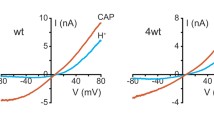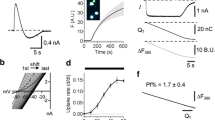Abstract
TRPV1 is a member of the transient receptor potential (TRP) family of cation channels. It is expressed in sensory neurons of the dorsal root and trigeminal ganglia as well as in a wide range of non-neuronal tissues. The channel proteins serve as polymodal receptors for various potentially harmful stimuli to prevent tissue damage by mediating unpleasant or painful sensations. Using Ca imaging and voltage-clamp recordings, we found that low millimolar doses of Ni2+ (NiSO4) are able to induce non-specific cation currents in a capsaicin-sensitive population of cultured mouse trigeminal ganglion neurons. In addition, we show that NiSO4 elicits intracellular Ca2+ transients and membrane currents in HEK293 and CHO cells heterologously expressing rat TRPV1. The use of voltage ramps from −100 to +100 mV revealed a strong outward rectification of these currents. Application of NiSO4 to the cytoplasmic face of inside-out membrane patches did not induce any currents. However, delivering NiSO4 to the extracellular face during outside-out recordings, we observed a significant increase in open probability paralleled by a decrease in channel conductance. When combined with other TRPV1 agonists, NiSO4 produces a bimodal effect on TRPV1 activity, depending on the strength and concentration of the second stimulus. Outwardly directed currents induced by low doses of capsaicin and nearly neutral pH values (∼pH = 7.0–6.5) were augmented by low doses of NiSO4. In contrast, responses to stronger stimuli were reduced by NiSO4. Moreover, we were able to identify amino acids involved in the effect of NiSO4 on TRPV1.








Similar content being viewed by others
References
Ahern G, Brooks I, Miyares R, Wang X (2005) Extracellular cations sensitize and gate capsaicin receptor TRPV1 modulating pain signaling. J Neurosci 25:5109–5116
Ahern G, Wang X, Miyares R (2006) Polyamines are potent ligands for the capsaicin receptor TRPV1. J Biol Chem 281:8991–8995
Bergman M, Bergman B, Söremark R (1980) Tissue accumulation of nickel released due to electrochemical corrosion of non-precious dental casting alloys. J Oral Rehabil 7:325–330
Boulais N, Pereira U, Lebonvallet N, Misery L (2007) The whole epidermis as the forefront of the sensory system. Exp Dermatol 16:634–635
Boulais N, Misery L (2008) The epidermis: a sensory tissue. Eur J Dermatol 18:119–127
Brauchi S, Orio P, Latorre R (2004) Clues to understanding cold sensation: thermodynamics and electrophysiological analysis of the cold receptor TRPM8. Proc Natl Acad Sci U S A 101:15494–15499
Caterina M, Schumacher M, Tominaga M, Rosen T, Levine J, Julius D (1997) The capsaicin receptor: a heat-activated ion channel in the pain pathway. Nature 389:816–824
Clapham D (2003) TRP channels as cellular sensors. Nature 426:517–524
Damann N, Rothermel M, Klupp B, Mettenleiter T, Hatt H, Wetzel C (2006) Chemosensory properties of murine nasal and cutaneous trigeminal neurons identified by viral tracing. BMC Neurosci 7:46
Goswami C, Dreger M, Otto H, Schwappach B, Hucho F (2006) Rapid disassembly of dynamic microtubules upon activation of the capsaicin receptor TRPV1. J Neurochem 96:254–266
Gunthorpe M, Szallasi A (2008) Peripheral TRPV1 receptors as targets for drug development: new molecules and mechanisms. Curr Pharm Des 14:32–41
Huang S, Bisogno T, Trevisani M, Al-Hayani A, De Petrocellis L, Fezza F, Tognetto M, Petros T, Krey J, Chu C, Miller J, Davies S, Geppetti P, Walker J, Di Marzo V (2002) An endogenous capsaicin-like substance with high potency at recombinant and native vanilloid VR1 receptors. Proc Natl Acad Sci U S A 99:8400–8405
Hwang S, Cho H, Kwak J, Lee S, Kang C, Jung J, Cho S, Min K, Suh Y, Kim D, Oh U (2000) Direct activation of capsaicin receptors by products of lipoxygenases: endogenous capsaicin-like substances. Proc Natl Acad Sci U S A 97:6155–6160
Ikoma A, Steinhoff M, Ständer S, Yosipovitch G, Schmelz M (2006) The neurobiology of itch. Nat Rev Neurosci 7:535–547
Imamachi N, Park G, Lee H, Anderson D, Simon M, Basbaum A, Han S (2009) TRPV1-expressing primary afferents generate behavioral responses to pruritogens via multiple mechanisms. Proc Natl Acad Sci U S A 106:11330–11335
Jordt S, Tominaga M, Julius D (2000) Acid potentiation of the capsaicin receptor determined by a key extracellular site. Proc Natl Acad Sci U S A 97:8134–8139
Kim A, Tang Z, Liu Q, Patel K, Maag D, Geng Y, Dong X (2008) Pirt, a phosphoinositide-binding protein, functions as a regulatory subunit of TRPV1. Cell 133:475–485
Matta J, Miyares R, Ahern G (2007) TRPV1 is a novel target for omega-3 polyunsaturated fatty acids. J Physiol 578:397–411
Misery L, Hermier M, Staniek V, Kanitakis J, Gaudillere A, Lachaux A, Schmitt D, Claudy A (1999) Congenital insensitivity to pain with anhidrosis: absence of substance P receptors in the skin. Br J Dermatol 140:190–191
Nilius B, Talavera K, Owsianik G, Prenen J, Droogmans G, Voets T (2005) Gating of TRP channels: a voltage connection? J Physiol 567:35–44
Paus R, Schmelz M, Bíró T, Steinhoff M (2006) Frontiers in pruritus research: scratching the brain for more effective itch therapy. J Clin Invest 116:1174–1186
Platika D, Boulos M, Baizer L, Fishman M (1985) Neuronal traits of clonal cell lines derived by fusion of dorsal root ganglia neurons with neuroblastoma cells. Proc Natl Acad Sci U S A 82:3499–3503
Riera C, Vogel H, Simon S, le Coutre J (2007) Artificial sweeteners and salts producing a metallic taste sensation activate TRPV1 receptors. Am J Physiol Regul Integr Comp Physiol 293:R626–R634
Riera C, Vogel H, Simon S, Damak S, le Coutre J (2009) Sensory attributes of complex tasting divalent salts are mediated by TRPM5 and TRPV1 channels. J Neurosci 29:2654–2662
Samitz M, Katz S (1975) Nickel dermatitis hazards from prostheses. In vivo and in vitro solubilization studies. Br J Dermatol 92:287–290
Schmelz M, Schmidt R, Bickel A, Handwerker H, Torebjörk H (1997) Specific C-receptors for itch in human skin. J Neurosci 17:8003–8008
Schmelz M, Schmid R, Handwerker H, Torebjörk H (2000) Encoding of burning pain from capsaicin-treated human skin in two categories of unmyelinated nerve fibres. Brain 123(Pt 3):560–571
Shim W, Tak M, Lee M, Kim M, Koo J, Lee C, Oh U (2007) TRPV1 mediates histamine-induced itching via the activation of phospholipase A2 and 12-lipoxygenase. J Neurosci 27:2331–2337
Sigel A, Sigel H, Sigel RKO (2007) Nickel and its surprising impact in nature. Metal ions in life sciences, vol 2. Wiley, Hoboken
Smart D, Gunthorpe M, Jerman J, Nasir S, Gray J, Muir A, Chambers J, Randall A, Davis J (2000) The endogenous lipid anandamide is a full agonist at the human vanilloid receptor (hVR1). Br J Pharmacol 129:227–230
Southall M, Li T, Gharibova L, Pei Y, Nicol G, Travers J (2003) Activation of epidermal vanilloid receptor-1 induces release of proinflammatory mediators in human keratinocytes. J Pharmacol Exp Ther 304:217–222
Staender S, Moormann C, Schumacher M, Buddenkotte J, Artuc M, Shpacovitch V, Brzoska T, Lippert U, Henz B, Luger T, Metze D, Steinhoff M (2004) Expression of vanilloid receptor subtype 1 in cutaneous sensory nerve fibers, mast cells, and epithelial cells of appendage structures. Exp Dermatol 13:129–139
Susankova K, Ettrich R, Vyklicky L, Teisinger J, Vlachova V (2007) Contribution of the putative inner-pore region to the gating of the transient receptor potential vanilloid subtype 1 channel (TRPV1). J Neurosci 27:7578–7585
Tominaga M, Caterina M, Malmberg A, Rosen T, Gilbert H, Skinner K, Raumann B, Basbaum A, Julius D (1998) The cloned capsaicin receptor integrates multiple pain-producing stimuli. Neuron 21:531–543
Voets T, Droogmans G, Wissenbach U, Janssens A, Flockerzi V, Nilius B (2004) The principle of temperature-dependent gating in cold- and heat-sensitive TRP channels. Nature 430:748–754
Zufall F, Hatt H, Firestein S (1993) Rapid application and removal of second messengers to cyclic nucleotide-gated channels from olfactory epithelium. Proc Natl Acad Sci U S A 90:9335–9339
Zygmunt P, Petersson J, Andersson D, Chuang H, Sørgård M, Di Marzo V, Julius D, Högestätt E (1999) Vanilloid receptors on sensory nerves mediate the vasodilator action of anandamide. Nature 400:452–457
Acknowledgments
We thank H. Bartel, T. Piofczyk, and Y. Cinar for technical assistance and H. Benecke for valuable discussion.
Author information
Authors and Affiliations
Corresponding author
Rights and permissions
About this article
Cite this article
Luebbert, M., Radtke, D., Wodarski, R. et al. Direct activation of transient receptor potential V1 by nickel ions. Pflugers Arch - Eur J Physiol 459, 737–750 (2010). https://doi.org/10.1007/s00424-009-0782-8
Received:
Revised:
Accepted:
Published:
Issue Date:
DOI: https://doi.org/10.1007/s00424-009-0782-8




